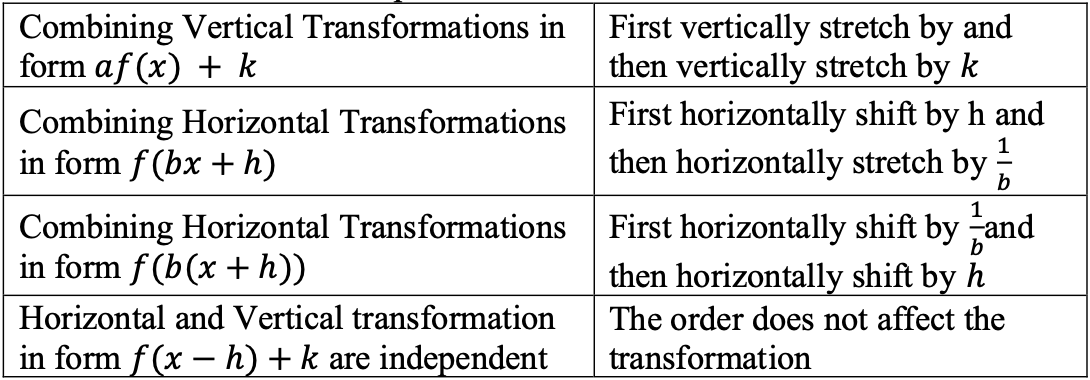General Information
Subject Area: Mathematics (B.E.S.T.)
Grade: 912
Strand: Functions
Date Adopted or Revised: 08/20
Status: State Board Approved
Benchmark Instructional Guide
Connecting Benchmarks/Horizontal Alignment
- MA.912.AR.2.4
- MA.912.AR.2.5
- MA.912.AR.3.7
- MA.912.AR.3.8
- MA.912.AR.4.4
- MA.912.AR.5.6
- MA.912.AR.5.7
- MA.912.AR.5.8
- MA.912.AR.5.9
- MA.912.F.1.1
Terms from the K-12 Glossary
- Coordinate plane
- Dilation
- Function notation
- Reflection
- Transformation
- Translation
Vertical Alignment
Previous Benchmarks
Next Benchmarks
Purpose and Instructional Strategies
In grade 8, students performed single transformations on two-dimensional figures. In Algebra I, students identified the effects of single transformations on linear, quadratic and absolute value functions. In Geometry, students performed multiple transformations on two-dimensional figures. In Mathematics for College Algebra, students identify effects of transformations on linear, quadratic, exponential, logarithmic and absolute value functions.- In this benchmark, students will examine the impact of two or more transformations of a given function. Instruction includes the use of graphing software to ensure adequate time for students to examine multiple transformations on the graphs of functions.
- When combining transformation, students will need to consider the order of the transformations.
- Vertical Transformations affect the output value of the function
- Given 4() − 2, vertically shifting by 2 and then vertically stretching by 4 does not create the same graph as vertically stretching by 4 and then vertically shifting by 2, because when we shift first, both the original function and the shift gets stretched, while only the original function gets stretched when we stretch first.
- When students see an expression such as 4() − 2, we must first multiply the output value of () by 4, causing a vertical stretch, and then subtract 2, causing the vertical shift. Therefore, students should be reminded that multiplication comes before addition.
- Horizontal Transformations affects the inputs of the function
- Given () = (5 + 2), we must first think about how the inputs to this function relate to the inputs to function . For example, if we know (5) = 12, what input to would produce that output? That means, what value of will allow () = (5 + 2)=12. We would need 5 +2 = 12, and when solved for , we would subtract 2, resulting in a horizontal shift, and then divide by 5 which gives us a horizontal compression.
- When students see an expression such as 4() − 2, we must first multiply the output value of () by 4, causing a vertical stretch, and then subtract 2, causing the vertical shift. Therefore, students should be reminded that multiplication comes before addition.
- Vertical Transformations affect the output value of the function

Common Misconceptions or Errors
- Similar to writing functions in vertex form, students may confuse effect of the sign of in ( + ). Direct these students to examine a graph of the two functions to see that the horizontal shift is opposite of the sign of .
- Students may think that a vertical and horizontal stretch from () and () look the same. For linear and quadratic functions, it can help to have a non-zero -intercept to visualize the difference.
Instructional Tasks
Instructional Task 1 (MTR.3.1)- A function is shown. () = 0.25( − 3)2 + 5
- Part A. What transformations occurred to the quadratic parent function () = 2?
- Part B. Is there a specific order that the transformations must occur?
Instructional Items
Instructional Item 1- Describe the effect of the transformation () = 4 on the function table below.

